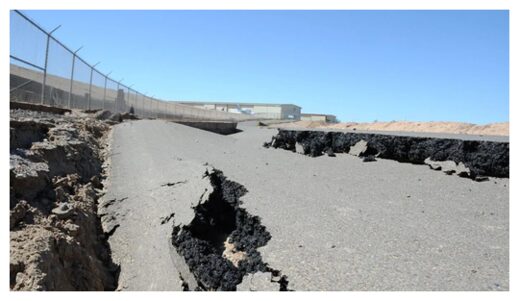
The earthquake sent waves through the ground around it, but high in the atmosphere, a very different sort of perturbation might have offered a forewarning of the earthquake's impending arrival, had anyone been able to see it. Subtle fluctuations in Earth's ionosphere, a region of charged particles high above the surface, preceded the Baja earthquake, said the authors of a new paper published in Advances in Space Research. Somehow, the fault that caused the earthquake may have been telegraphing its impending rupture, sending out a rush of electrically charged particles that resonated in the ionosphere.
The ionosphere, which begins about 48 kilometers above Earth's surface and stretches to around 965 kilometers, is where incoming energy from the Sun ionizes molecules in the atmosphere, knocking off electrons. The abundance of charged particles means the ionosphere reacts to electric and magnetic fields, something other regions of the atmosphere generally do not do.
Using data from the Massachusetts Institute of Technology's Haystack Observatory on the density of electrons in the ionosphere, a team of Chinese and U.S. researchers analyzed the atmosphere above the Baja California region for 72 days both before and after the earthquake. After controlling for other things that might have been affecting the ionosphere, they said they saw a clear anomaly — a spike in the number of ionospheric electrons — on 25 March, 10 days before the earthquake. The electron spike was located over the earthquake's epicenter, and it didn't look like anything else they'd seen in the data.
We can imagine it to be something like ripples in a lake, said Chen Zhou, a researcher at Wuhan University in China and a coauthor of the paper. The electron signal looked like a brief, but telling, redistribution of particles from their normal movements and positions, one researchers were able to catch as it went by.
Zhou and his colleagues said their work could support a theory that faults release electrical energy in the days leading up to an earthquake. How exactly this happens isn't clear — some scientists think it's the result of radon gas released by a fault ionizing air molecules, whereas others hold that rocks under stress can release bursts of electrons.
Ripples in the Atmosphere
Scientists have been trying to tie disruptions in the ionosphere to earthquakes for decades. One day, the technique might even give scientists a way to reliably predict earthquakes days before they happen, something impossible today. A number of papers have claimed to find links between rupturing faults and the ionosphere, though the theory has also attracted its fair share of criticism.
Much of the criticism centers on the fact that the ionosphere is a noisy place, statistically speaking. Everything from solar radiation to air currents to the changing seasons leaves an imprint on the ionosphere, and it's extremely difficult amid the clamor to pick out any correlation between things near Earth's surface and an ionospheric disturbance.
"The biggest problem is that [the ionosphere] is so variable that sometimes the signal due to coupling with the lithosphere could be very tiny," said Angelo De Santis, a geophysicist and director of research at the National Institute of Geophysics and Volcanology in Italy. "So you have to analyze with statistical tools to be sure the correlation you find is robust."
But the choice of which statistical tools to use can make a big difference. On that note, De Santis said he's not entirely convinced by the Baja quake paper. The authors' choice of equations may not have been nuanced enough to fully isolate the anomalies they were looking for, he said, and their choice of the mean, rather than the median, to calculate the baseline may have skewed their results.
Zhou is well aware of the difficulties of processing data from the ionosphere. "We need to be very careful about our data processing. We need to develop some very elegant algorithms to derive the very short, but certain, characteristics of these earthquake signals," he said.
Challenging Detections
Our data and knowledge may not yet be good enough to pinpoint disturbances in the ionosphere related to just one earthquake. In a similar study published in 2019, De Santis and his coauthors looked at more than 1,300 earthquakes from around the world. They tied similar ionospheric disturbances to earthquakes, but that work took a broader approach that was less likely to get fooled by false signals.
Another way to make earthquake hunting more precise, said De Santis, is to use more than one type of signal. Things like fluctuations in the magnetosphere, which lies above the ionosphere; seismic activity; and even ground temperature can presage earthquakes as well.
It's something Zhou acknowledged as well. "The ionosphere is not the only means of prediction," he said. "We need to use all kinds of data, all kinds of monitoring."



Reader Comments
to our Newsletter